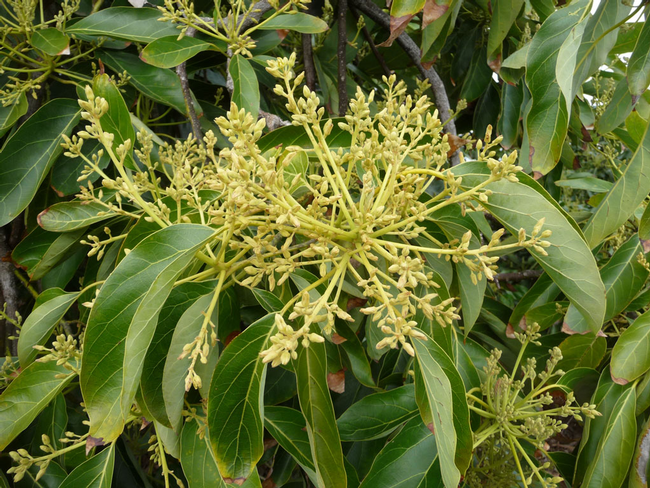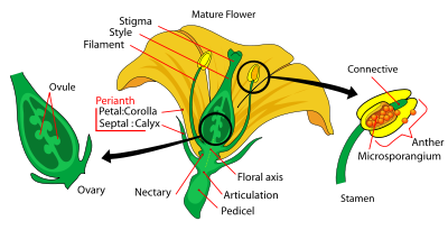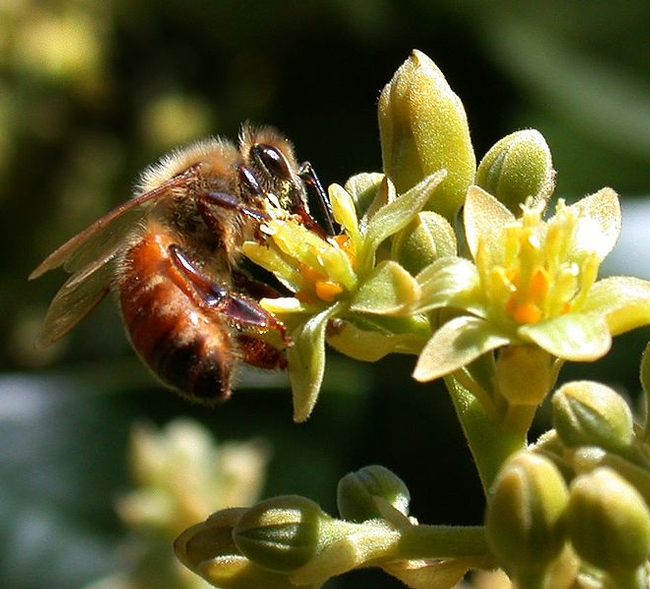Avocado trees can appear completely covered with flowers. A typical full grown healthy avocado tree in California can produce up to a million flowers a year, but, on the average, fewer than 200 flowers per tree will set fruit that will hold and develop to maturity and harvest (about 10,000 lbs/acre, or less). Upon occasion, we have seen some groves with trees setting an average of 500 flowers per tree (25,000 lbs/acre), but this is rare. More commonly, only 100 flowers (or less) per tree will set and hold fruit to maturity (5,000 lbs/acre or less), much to the distress of growers (Bender 2013). Flowering is typically spread over six to eight weeks.
The avocado flower has both functional male and female organs. The male floral organ, which produces pollen, is comprised of the anthers and stamens. The female floral organ is comprised of the stigma (which receives the pollen), style and the ovary. The flowers are small (10 mm diameter). The flowers are usually only open for 2–6 hours, then close and open again for 2–6 hours on the second day. When a flower opens for a second time, it produces pollen and the stigma is not receptive. Flowers then close and remain closed. Flowers will usually be one sex in the morning, closed in the middle of the day and the opposite sex in the afternoon. The timing of the sex phases can be quite defined, but environmental conditions will affect the timing and duration of the male and female phases. The mature tree can produce in excess of a million flowers during the flowering period.
Avocado cultivars are classified in two groups (A or B) based upon their flowering behavior. In the type ‘A' cultivars, the female organs are receptive to pollen in the morning and the pollen is released in the afternoon. Unfortunately, most of the currently available "B" varieties are classed as "greenskins", which return less to growers. In the type B'cultivars, the pollen is released in the morning, while the female organs are receptive in the afternoon. Type A cultivars include: Hass, Gwen, Lamb Hass, Pinkerton, Reed, Gem, and Harvest. Type B cultivars include: Bacon, Ettinger, Fuerte, Sharwill, Sir Prize, Walter Hole, Zutano, Marvel and Nobel. Both type. It is believed that the interplanting of complementary flower types can boost fruit set and therefore yield by making pollen available. The separation in time of the male and female phases has led most observers to believe that a vector or "pollinator" is needed to move pollen from one flower to another.
Steps to take to Improve Pollination (Bender 2014):
1. Bring beehives into the grove. The University of California farm advisors have usually recommended 1 – 2 strong hives per acre, but Ish-Am (2000) suggests that 1 hive is rarely sufficient, and in many cases 4 hives are required. California growers usually have to rent hives (in 2002 hive rentals averaged $42 per hive), but sometimes beekeepers will drop a load of 80 hives for free if the grower has good bee forage nearby. Bees should have water available; floating boards on ponds or reservoirs enables them to land and drink without drowning.
2. Add pollinizers to the grove. Ish-Am recommends a pollinizer tree row be located at least every fourth row. Some growers in California use pollinizers as wind-breaks around the grove, and some replace thinned-out trees with pollinizers.
3. Keep the orchard open. Direct sunlight should reach the lower branches of each tree in order for the trees to produce a “wall” of flowers down the ground. In avocado production, this can only be accomplished by pruning the upper branches on a yearly basis. Keeping open channels through the grove encourages the flight of bees.
4. Other types of bees? Bumblebees have been reported to increase yield in avocados in Israel where honeybee populations were low. New World Carniolan bees have been used in an experiment in San Diego County for pollination: results were inconclusive as to whether they increased yield compared to Italian honeybees, but it was found that they gather more nectar from avocado (Fetscher et al. 2000). Work with these bees, and other wild bees, may eventually reveal a more efficient pollinator for avocado.


